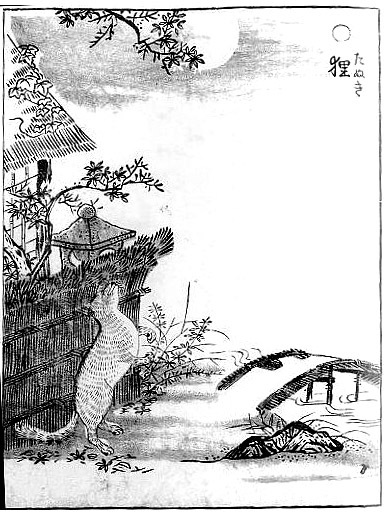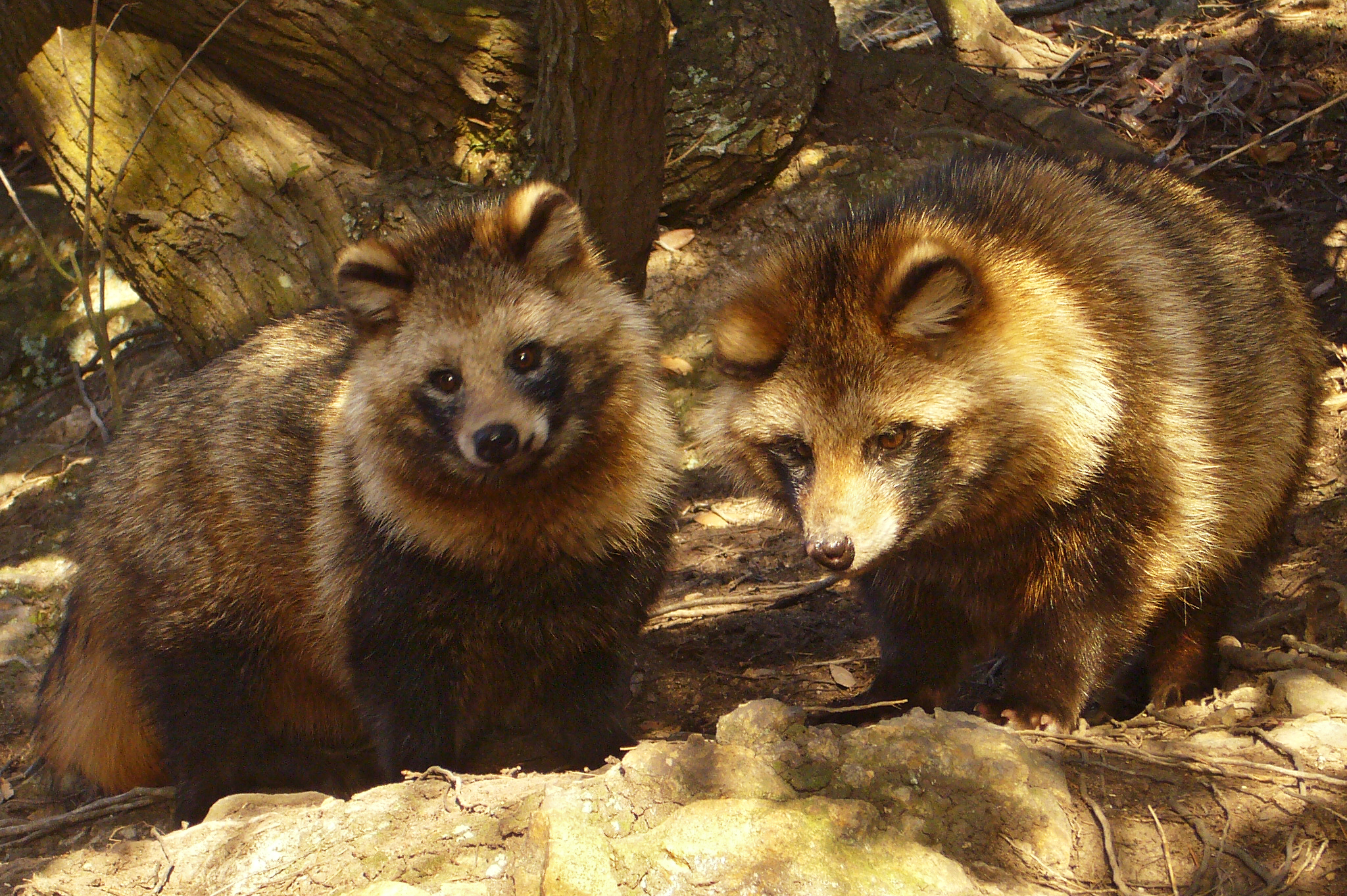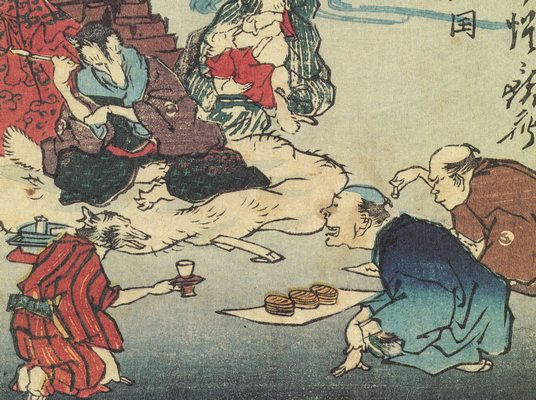|
Bake-danuki
''Bake-danuki'' () are a kind of '' yōkai'' (supernatural beings) found in the classics and in the folklore and legends of various places in Japan, commonly associated with the Japanese raccoon dog or ''tanuki''. Although the ''tanuki'' is a real, extant animal, the ''bake-danuki'' that appears in literature has always been depicted as a strange, even supernatural animal. The earliest appearance of the ''bake-danuki'' in literature, in the chapter about Empress Suiko in the '' Nihon Shoki'' written during the Nara period, there are such passages as "in two months of spring, there are tanuki in the country of Mutsu (), they turn into humans and sing songs ()." Bake-danuki subsequently appear in such classics as the Nihon Ryōiki and the Uji Shūi Monogatari. In some regions of Japan, ''bake-danuki'' are reputed to have abilities similar to those attributed to ''kitsune'' (foxes): they can shapeshift into other things or people, and can possess human beings. Many legends of ''t ... [...More Info...] [...Related Items...] OR: [Wikipedia] [Google] [Baidu] |
Japanese Raccoon Dog
The Japanese raccoon dog (''Nyctereutes viverrinus''), also known as the ''tanuki'' ( ja, , , ), is a species of canid endemic to Japan. It is one of two species in the genus ''Nyctereutes'', alongside the common raccoon dog (''N. procyonoides''), of which it was formerly thought to be a subspecies. The Japanese raccoon dog has a relatively smaller stomach and shorter fur of lesser insulation value than mainland raccoon dogs. A rare, white colour type can also be found. Within Japanese folklore, the ''tanuki'' have had a significant role since ancient times. The legendary ''tanuki'' are reputed to be mischievous and jolly, masters of disguise and shapeshifting but somewhat gullible and absentminded. The animals have also been common in Japanese art, particularly as subjects for statues. Japanese etymology While ''tanuki'' are prominent in Japanese folklore and proverbs, they were not always clearly distinguished from other animals with a similar appearance. In local dialects, ' ... [...More Info...] [...Related Items...] OR: [Wikipedia] [Google] [Baidu] |
Bunbuku Chagama
is a Japanese folktale or fairy tale about a '' tanuki'' (raccoon dog), that uses its shapeshifting powers to reward its rescuer for his kindness. Overview The fairy tale version has been translated into English as "The Accomplished and Lucky Teakettle" (1871) by Mitford and as "The Wonderful Tea Kettle" (1886) in the crepe-paper book series published by T. Hasegawa. The raccoon dog is ill-treated as a tea-kettle at a temple and sold off; it later performs a dance and tightrope walking routine, and the subsequent owner turned showman acquires great wealth. In most folk tale versions, the raccoon dog or fox transforms into a kettle so that its human friend or benefactor can make profit by selling the fake kettle, typically to a priest. In legend, Bunbuku chagama is the name of a tea kettle owned by priest Shukaku who turned out to be an ancient raccoon dog or '' mujina'', the supposed kettle still on view at temple which Shukaku served. Etymology One suggested hypoth ... [...More Info...] [...Related Items...] OR: [Wikipedia] [Google] [Baidu] |
Mujina
is an old Japanese term primarily referring to the Japanese badger, but traditionally to the Japanese raccoon dog (''tanuki''), causing confusion. Adding to the confusion, it may also refer to the introduced masked palm civet, and in some regions badger-like animals or Japanese raccoon dog are also called ''mami''. Appearance The ''mujina'' is said to be a raccoon-faced creature in its natural form, with the main body being that of a Japanese badger. In some parts of Japan, they are incorrectly referred to as the ''tanuki'', with whom they are closely related to in terms of appearance as well as actions- even though the ''tanuki'' are biologically related to the fox and dog.Reeves, David. “A Brief Introduction to Aoki Rosui and Annotated Translation of his Text Otogi Hyaku Monogatari.” ''Masters Theses'', 240, 2015, pp. 37-40. https://doi.org/10.7275/7012662. Accessed 25 Nov 2022. The ''mujina'' in specific are known to be able to inflate their bellies, creating music by ... [...More Info...] [...Related Items...] OR: [Wikipedia] [Google] [Baidu] |
Yashima No Hage-tanuki
is a , who appears in the legends of Yashima, Takamatsu, Kagawa Prefecture. He is also called Tasaburō-tanuki (太三郎狸), Yashima no Hage, and Yashima no Kamuro (屋島の禿). He is counted as one of the "three famous tanuki of Japan", along with Danzaburou-danuki of Sado and Shibaemon-tanuki of Awaji. He is also famous due to his appearance in the Studio Ghibli animated movie, '' Heisei Tanuki Gassen Ponpoko''. 村上2011年、126-127頁。 Legend In the past, there was a tanuki who was wounded by a fatal arrow shot, but was saved by Taira no Shigemori. To pay his debt of gratitude, the tanuki swore to protect the Taira clan. This wounded tanuki's descendant is said to be Yashima no Hage-tanuki. 赤塚1995年、99–100頁。 After the Taira clan was ruined, Hage-tanuki became the protector deity of Yashima-ji, the 84th temple on the Shikoku 88-temple pilgrimage. His skill at transformation was called the best in Japan, and he achieved the rank of supreme commande ... [...More Info...] [...Related Items...] OR: [Wikipedia] [Google] [Baidu] |
Kachi-kachi Yama
, also known as ''Kachi-Kachi Mountain'' and ''The Farmer and the Badger'', is a Japanese folktale in which a '' tanuki'' (Japanese raccoon dog) is the villain, rather than the more usual boisterous, well-endowed alcoholic. Story The trouble-making ''tanuki'' As the story goes, a man caught a troublesome ''tanuki'' in his fields, and tied it to a tree to kill and cook it later. When the man left for town, the ''tanuki'' cried and begged the man's wife who was making some ''mochi'', a sweet rice dish, to set him free, promising he would help her. The wife freed the animal, only to have it turn on her and kill her. The ''tanuki'' then planned a foul trick. Using its shapeshifting abilities, the ''tanuki'' disguised itself as the wife and cooked a soup, using the dead woman's flesh. When the man came home, the ''tanuki'' served him the soup. After the meal, the ''tanuki'' reverted to its original appearance and revealed its treachery before running off and leaving the poor man i ... [...More Info...] [...Related Items...] OR: [Wikipedia] [Google] [Baidu] |
Danzaburou-danuki
is a bake-danuki passed down in stories on Sado Island, particularly in Aikawa and Niigata. In Sado, tanuki were called "mujina (狢)", thus he was also referred to as Danzaburou-mujina (団三郎狢). In the Ukiyo-e, its name was written as 同三狸." Together with the Shibaemon-tanuki of Awaji Island, and the Yashima no Hage-tanuki of Kagawa, they form the " three famous tanuki" of Japan. Legend The supreme commander of the tanuki on Sado Island, most tales of Danzaburou focus on his trickery of humans. He would create wall-like structures to block people's paths at night, fooled people with mirages and sold leaves from trees by making them look as if they were made of gold. He also created mirages to lure people into his lair (said to be a hole in the ground or a cellar), making it appear as a splendid estate. If he ever became ill, Danzaburou would disguise himself as a human and visit human doctors for treatment. His reputation was not all bad, however. He was said to ha ... [...More Info...] [...Related Items...] OR: [Wikipedia] [Google] [Baidu] |
Wild Boar
The wild boar (''Sus scrofa''), also known as the wild swine, common wild pig, Eurasian wild pig, or simply wild pig, is a suid native to much of Eurasia and North Africa, and has been introduced to the Americas and Oceania. The species is now one of the widest-ranging mammals in the world, as well as the most widespread suiform. It has been assessed as least concern on the IUCN Red List due to its wide range, high numbers, and adaptability to a diversity of habitats. It has become an invasive species in part of its introduced range. Wild boars probably originated in Southeast Asia during the Early Pleistocene and outcompeted other suid species as they spread throughout the Old World. , up to 16 subspecies are recognized, which are divided into four regional groupings based on skull height and lacrimal bone length. The species lives in matriarchal societies consisting of interrelated females and their young (both male and female). Fully grown males are usually solitary ... [...More Info...] [...Related Items...] OR: [Wikipedia] [Google] [Baidu] |
China
China, officially the People's Republic of China (PRC), is a country in East Asia. It is the world's most populous country, with a population exceeding 1.4 billion, slightly ahead of India. China spans the equivalent of five time zones and borders fourteen countries by land, the most of any country in the world, tied with Russia. Covering an area of approximately , it is the world's third largest country by total land area. The country consists of 22 provinces, five autonomous regions, four municipalities, and two Special Administrative Regions (Hong Kong and Macau). The national capital is Beijing, and the most populous city and financial center is Shanghai. Modern Chinese trace their origins to a cradle of civilization in the fertile basin of the Yellow River in the North China Plain. The semi-legendary Xia dynasty in the 21st century BCE and the well-attested Shang and Zhou dynasties developed a bureaucratic political system to serve hereditary monarchies, or ... [...More Info...] [...Related Items...] OR: [Wikipedia] [Google] [Baidu] |
Leopard Cat
The leopard cat (''Prionailurus bengalensis'') is a small wild cat native to continental South, Southeast, and East Asia. Since 2002 it has been listed as Least Concern on the IUCN Red List as it is widely distributed although threatened by habitat loss and hunting in parts of its range. Historically, the leopard cat of continental Asia was considered the same species as the Sunda leopard cat. As of 2017, the latter is recognised as a distinct species, with the taxonomic name ''Prionailurus javanensis''. Leopard cat subspecies differ widely in fur colour, tail length, skull shape and size of carnassials. Archaeological evidence indicates that the leopard cat was the first cat species domesticated in Neolithic China about 5,000 years ago in Shaanxi and Henan Provinces. Characteristics A leopard cat is about the size of a domestic cat, but more slender, with longer legs and well-defined webs between its toes. Its small head is marked with two prominent dark stripes and a ... [...More Info...] [...Related Items...] OR: [Wikipedia] [Google] [Baidu] |
Apotheosis
Apotheosis (, ), also called divinization or deification (), is the glorification of a subject to divine levels and, commonly, the treatment of a human being, any other living thing, or an abstract idea in the likeness of a deity. The term has meanings in theology, where it refers to a belief, and in art, where it refers to a genre. In theology, ''apotheosis'' refers to the idea that an individual has been raised to godlike stature. In art, the term refers to the treatment of any subject (a figure, group, locale, motif, convention or melody) in a particularly grand or exalted manner. Ancient Near East Before the Hellenistic period, imperial cults were known in Ancient Egypt ( pharaohs) and Mesopotamia (from Naram-Sin through Hammurabi). In the New Kingdom of Egypt, all deceased pharaohs were deified as the god Osiris. The architect Imhotep was deified after his death. Ancient Greece From at least the Geometric period of the ninth century BC, the long-deceased h ... [...More Info...] [...Related Items...] OR: [Wikipedia] [Google] [Baidu] |
Japanese Badger
The Japanese badger (''Meles anakuma'') is a species of carnivoran of the family Mustelidae, the weasels and their kin. Endemic to Japan, it is found on Honshu, Kyushu, Shikoku, and Shōdoshima. It shares the genus '' Meles'' with its close relatives, the European (''M. meles'') and Asian (''M. leucurus'') badgers. In Japan it is called by the name ''anaguma'' (穴熊) meaning "hole-bear", or ''mujina'' (むじな, 狢). Description Japanese badgers are generally smaller (average length in males, in females) and less sexually dimorphic (except in the size of the canine teeth) than their European counterparts. Tail length is between . This species is similar or mildly larger than the Asian badger. Adults usually weigh from . The average weight of female Japanese badgers in one study from the Tokyo area was found to be while that of males was . In the Yamaguchi Prefecture, the average spring weight of female and male Japanese badgers was and .Tanaka, H. 2002. ''Ecology a ... [...More Info...] [...Related Items...] OR: [Wikipedia] [Google] [Baidu] |








.jpg)